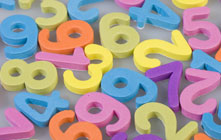Lesson Plans on Comparing Decimals
Comparing decimals can sound challenging for children. However, the key to comparing decimals is simple and 2-fold. First, the children must understand place values of decimals (tenths, hundredths, thousandths, etc.). Second, always start with the digits in the tenths column, and move to the right as needed.

Teaching Strategies for Comparing Decimals
Place Values
By the time students begin learning decimals, commonly in fourth grade, they should have a good understanding of the place values in whole numbers. These values for a large number - beginning at the right and moving left - are units, tens, hundreds, thousands, ten thousands and so on. One of the first things they learn about decimals is that they also have place values.
Decimal place values are the mirror image of whole-number place values, with -ths added to the names. In other words, you start at the left and move to the right. Keeping with the mirror image analogy, you may want to liken the decimal point to the units place. Then, there are the tenths, hundredths, thousandths, ten thousandths, etc. To begin comparing decimals, students need to have this concept mastered.
Lesson Plan
Generate Interest
Review place values with The Place Value Rap by Tim Bedley and Ben Jacobs. Print out lyrics or have the students make up their own mnemonics for remembering the place values.
Presentation
Model the steps by completing them on the board. Be sure to explain what you are doing aloud to help the students follow along.
Draw a chart. Label the top row with the place value names for decimals. Put decimal numbers in the next two rows, such as .135 and .041.
Begin in the tenths column. If one number is larger than the other (1 in .135 is larger than 0 in .041), then that decimal is larger than the other, no matter what other numbers appear to the right.
If the two numbers are that same, as in .641 and .639, move to the hundredths column. Here, you would see that 4 in .641 is larger than 3 in .639. You can stop there, because this shows that .641 is larger than .639.
If the numbers are the same, as in .012 and .013, move to the next column and repeat the procedure as often as necessary.
Guided Practice
Worksheets are an obvious possibility for giving students a chance to practice what they learned. However, students might be more engaged if you reinforce the material with a game instead. For instance, give each student a card with a decimal number written on it. Instruct them to put themselves in order without speaking.
Alternatively, make a large number line and have your students put decimals numbers in numerical order. Visualizing decimals on a number line will especially help your visual learners.
Closure
Closure is sometimes done through classroom discussion, with the teacher asking questions to stimulate the discussion. Students are given the opportunity to say what they learned during the lesson, what questions they still have about the topic and how the new material fits in with what they have already learned. This activity not only helps the student, but gives the teacher insight into how the students learn and what can be done differently in later classes.
Other Articles You May Be Interested In
-
Tips to Help Kids Understand Decimals

The decimal numbering system is the basis for modern number theory. Read on to learn how to help your children understand decimal places, percentages, and place values.
-
Tips to Helping your Fifth Grader with Place Value and Decimals in Their Math Homework

Place values and decimal mathematics can be confusing, but the way to master decimals is to first learn how place values work. By learning place values and decimals, your child will be able to better understand the math concepts they will learn in middle and high school.
We Found 7 Tutors You Might Be Interested In
Huntington Learning

- What Huntington Learning offers:
- Online and in-center tutoring
- One on one tutoring
- Every Huntington tutor is certified and trained extensively on the most effective teaching methods
K12

- What K12 offers:
- Online tutoring
- Has a strong and effective partnership with public and private schools
- AdvancED-accredited corporation meeting the highest standards of educational management
Kaplan Kids

- What Kaplan Kids offers:
- Online tutoring
- Customized learning plans
- Real-Time Progress Reports track your child's progress
Kumon

- What Kumon offers:
- In-center tutoring
- Individualized programs for your child
- Helps your child develop the skills and study habits needed to improve their academic performance
Sylvan Learning

- What Sylvan Learning offers:
- Online and in-center tutoring
- Sylvan tutors are certified teachers who provide personalized instruction
- Regular assessment and progress reports
Tutor Doctor

- What Tutor Doctor offers:
- In-Home tutoring
- One on one attention by the tutor
- Develops personlized programs by working with your child's existing homework
TutorVista

- What TutorVista offers:
- Online tutoring
- Student works one-on-one with a professional tutor
- Using the virtual whiteboard workspace to share problems, solutions and explanations